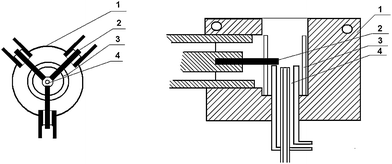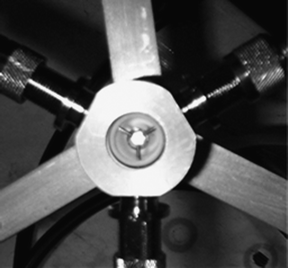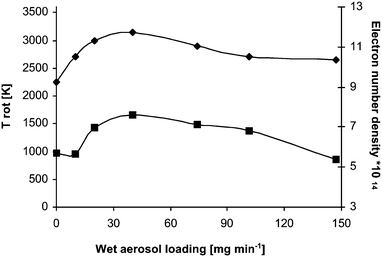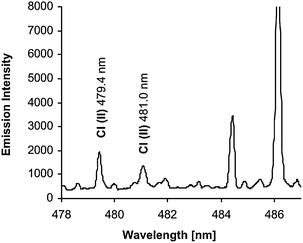A three phase rotating field microwave plasma design for a low-flow helium plasma generation†
Krzysztof
Jankowski
*a,
Andrzej P.
Ramsza
b,
Edward
Reszke
c and
Michał
Strzelec
a
aWarsaw University of Technology, Faculty of Chemistry, Department of Analytical Chemistry, ul. Noakowskiego 3, 00-664, Warsaw, Poland. E-mail: kj@ch.pw.edu.pl; Fax: +4822-6282741; Tel: +4822-2345178
bInstitute of Applied Optics, ul. Kamionkowska 18, 03-805, Warszawa, Poland
cErtec-Poland, ul. Rogowska 146/5, 54-440, Wrocław, Poland
First published on 14th October 2009
Abstract
A new 2.45 GHz frequency powered helium plasma source with rotating microwave field generated within the three electrodes has been developed. A stable symmetrical low-flow helium discharge is formed at atmospheric pressure with a minimum field strength at the axis. Thus, a triangle shaped ring plasma is obtained with a channel at the center through which the sample is introduced using a laminar dual-flow injector. The helium plasma operates at a microwave input power of 30–150 W and total gas flow of 200–1500 ml min−1 and it is self-igniting. The preliminary investigation of the plasma fundamental parameters provides a He excitation temperature up to 4000 K, rotational temperature (OH) up to 3100 K and electron number density up to 7.5 × 1014 cm−3. To demonstrate the plasma robustness, both the tolerance for water loading and the excitation and ionisation capability for hydride-forming elements as well as for ionic chlorine are presented. The detection limits for As, Sb and Hg obtained by continuous hydride generation without hydrogen separation were 12, 10 and 9 ng ml−1, respectively.
Introduction
In recent years, helium plasma sources have been extensively investigated to be used as an excitation source for optical emission spectrometry (OES) as well as an ionization source for mass spectrometry (MS).1–5 Helium is attractive as a plasma gas because it possesses a higher thermal conductivity compared to argon, thus improving desolvation, vaporization, and atomization efficiencies. Helium plasmas exhibit higher excitation and ionization efficiencies and thus could be used for detection of hard-to-ionize elements including nonmetals. The use of helium as a plasma gas for mass spectrometry promises to reduce spectral interferences that prevent the use of argon plasmas in certain applications. The limitations of helium plasma include difficulty in plasma formation, relatively low gas temperature and electron number density and relatively high maintenance costs.Among other plasma sources, some interesting approaches of helium plasma powered with microwave frequencies have been reported, however, problems with loading of large amounts of analytes to the plasma are usually observed.1–3 In this work, a new concept of maintaining helium plasma based on three phase rotating field microwave source is presented. The design and fundamental characteristics of the discharge as well as the analytical potential were preliminarily investigated.
The concept and the design of a 3-phase rotating field microwave plasma
The new plasma is sustained with rotating microwave field. The rotating field generated by 3 electrodes makes the discharge well matched to the generator but the most valuable is that in the balanced 3-phase system no electric current can flow through the discharge centre, which in cases when the plasma stability or symmetry is imposed, must remain neutral.These three electrodes are supplied from 3 symmetrically placed N-type coaxial connectors which are connected via 3 separate coaxial cables to a 3-phase microwave power splitter. That device was realized by splitting the output of a regular microwave power generator by 3 equal power lines and adjusting phase shifts between those lines to import the 120 degrees phase shifts between them. The exact design of the splitter is very important for the effective and reflectionless propagation of the microwave field along the electrode. In order to assure that the 3-phase supply is insensitive to plasma impedance, each of the 3 lines was also equipped with a microwave circulator and a dummy load.6
The 3-phase rotating field microwave plasma assembly with 3 electrodes is shown in Fig. 1. It consists of a water cooled cylindrically shaped jacket at the centre of which there are 3 stainless steel 1.6 mm in diameter electrodes supplied from 3 symmetrically placed N-type coaxial connectors. The distance between the 3 electrodes formed a regular 3 × 3 mm triangle and the helium discharge is maintained between the electrodes. The operating power of the regular generator is ranging from 30 to 150 W and, correspondingly, the power in each of the 3 phase lines is 10 to 50 W. Helium is supplied to the source with a dual-flow injector which consists of an internal ceramic tube inserted in the outer quartz tube placed in the brass body. Outer plasma gas flow of 1.0 L min−1 is used to form the discharge and to prevent the electrodes against corrosion. Emission lines of iron, chromium and manganese are not observed in the microwave induced plasma (MIP) spectrum. The sample is introduced via a 1 mm i.d. (5 mm o.d.) ceramic injector with a helium gas flow rate of 0.1 to 0.5 L min−1. The injector is placed close to the discharge, perpendicularly to the plane of the electrodes and 2 mm below this plane.
 | ||
| Fig. 1 Schematic diagram of the three-phase rotating field microwave plasma design: 1- water cooled brass jacket; 2- stainless steel electrode; 3- ceramic insulator; 4- dual-flow injector. | ||
The new construction differs from the known microwave induced plasma (MIP) and inductively coupled plasma (ICP) designs. For many different approaches used to maintain a helium discharge, especially those powered with microwave frequencies, a difficulty of operation with He plasma due to the remarkable erosion of the torch as a result of high plasma temperature was noticed. In our design, which could be maintained in the open space, the presence of the torch is essentially not required. The torch is replaced with a laminar dual-flow injector to support the discharge with the plasma gas as well as to introduce a sample precisely through the central part of the discharge. Both the mutual placement of the electrodes and the injector and the distance between the exit of the injector tube and the plasma generating region seem to be critical to obtain an adequate plasma geometry and should be optimized.
Microwave power was supplied to the source from a 2.45 GHz generator through a splitter (Ertec-Poland, Wrocław, Poland). The plasma was axially viewed with a MIP-750MV sequential spectrometer (Analab, Warsaw, Poland).
Plasma appearance
A photograph of the 3-phase rotating field helium MIP is shown in Fig. 2. The shape and the physical appearance of the microwave helium plasma differs markedly from the He plasma sources reported previously.1–5 The characteristic feature of the discharge is that it can form a triangle shaped ring with a hole at its centre through which the sample is introduced. Hence, the power density of the discharge is higher comparing to the other common microwave plasmas due to the small plasma volume of about 0.05 cm3. At identical power settings, assuming similar power transfer efficiencies, the helium plasma is more intense than those previously reported.1 The 2 mm-long analytical channel passes through the centre of the plasma, and the surrounding plasma zone provides efficient energy transfer. The presence of the central channel in the discharge offers an easy method of sample introduction into the discharge and enhances the interaction between the sample and the plasma. However, the length of the high temperature region in the plasma is much shorter than in common plasma sources, resulting in shorter analyte residence time in the plasma. | ||
| Fig. 2 Photograph of the three-phase rotating field helium MIP. | ||
The attractiveness of this discharge lies in its ability to be operated without formation a cooler tail of the plasma. Viewing such a plasma axially offers several advantages, including a reduction of self-absorption caused by the cool absorbing atoms usually present in the plasma tail. As a result, a reduction of matrix effects and the lowering of detection limits could be expected.
The new plasma seems to be interesting as an ionization source for mass spectral analysis due to possibility of avoiding problems related to the plasma tailing like ion recombination in the cooler plasma zone, interaction between the plasma and the sampling cone or the effect of secondary discharge.
Moreover, the plasma is self-igniting for microwave power levels exceeding 70 W. The self ignition of the discharge is of great practical interest since it overcomes the otherwise necessary external ignition. This simplified the design of both the external optics for optical emission measurements in the vacuum UV region and the ionisation chamber for mass spectrometry applications.
Preliminary results and discussion
Plasma diagnostics
To establish the basic physical parameters of the source, plasma temperatures and electron number density were determined under various operating conditions including microwave power level, gas flow rates and plasma loading with liquid and gaseous samples. These properties are commonly used to compare analytical performance indices of plasma-based techniques and to understand vaporization, atomization, excitation, and ionization processes in various discharges.Both the rotational temperature for OH radicals and helium excitation temperature were measured by the Boltzmann plot method. The respective spectral data are collected in Tables 1 and 2. Electron number density values were calculated from the Hβ line broadening. The emission spectra of the 3 phase rotating field microwave helium plasma viewed axially provide a rotational temperature (Trot), excitation temperature (Texc), and electron number density (ne) of 2000 to 3100 K, 3500 to 4000 K, and 6 to 7.5 · 1014 cm3, respectively. These values are higher compared to those previously reported for various helium MIPs.1–3 This could be explained by the higher power density of the discharge.
| He line [nm] | Excitation energy [cm−1] | Statistical weight | Transition probability [108 s−1] |
|---|---|---|---|
| 388.9 | 185565 | 9 | 0.095 |
| 447.2 | 191445 | 15 | 0.251 |
| 471.3 | 190298 | 3 | 0.106 |
| 492.2 | 191447 | 5 | 0.202 |
| 501.6 | 186210 | 3 | 0.134 |
| 667.8 | 186105 | 5 | 0.638 |
| OH Q1 line [nm] | Excitation energy [cm−1] | Transition probability [108s−1] |
|---|---|---|
| 307.8 | 32475 | 10 |
| 308.0 | 32543 | 17 |
| 308.3 | 32779 | 33.7 |
| 308.5 | 32948 | 42.2 |
| 308.7 | 33150 | 50.6 |
| 311.0 | 35462 | 100.6 |
| 311.5 | 35915 | 108.8 |
| 312.0 | 36397 | 125.2 |
| 313.7 | 38008 | 149.6 |
Plasma tolerance to water loading
To establish the plasma tolerance to water loading for the three phase rotating field microwave plasma system, the effect of the aerosol flow rate on rotational temperature and electron number density in the plasma was investigated. Aqueous aerosol was injected into the plasma without desolvation using the ultrasonic nebulizer (model NOVA-1, Optolab, Poland). The nebulizer gas flow rate was 0.5 L min−1.The effect of aerosol loading on the rotational temperature (Trot) and the electron number density (ne) of the discharge is illustrated in Fig. 3. Each data point represents an average of 3 measurements. The introduction of wet aerosol causes an increase of the measured plasma parameters and shows the robustness of the microwave frequency plasma against large sample volumes of up to 150 mg min−1. Initially, the aerosol loading is manifested as a rapid increase of Trot and ne by a factor of 1.35, comparing with respective values measured for dry helium plasma. Importantly, both Trot and ne remain relatively constant for a wide range of aerosol loadings between 20 and 100 mg min−1, decreasing as one approaches 100 mg min−1. Moreover, the Hβ line intensity remains widely unaffected for aerosol loadings between 20–60 mg min−1. It should be noticed that plasma overloading is observed by a decrease of the Hβ line intensity, while the discharge does not extinguish even for a 150 mg min−1 of aerosol loading. Hence, the new helium plasma is able to tolerate a much higher amount of water than other helium plasmas previously reported.1–5,7 This could be explained both by the relatively high ne values present in the plasma and relatively high power density of the discharge.
 | ||
| Fig. 3 The effect of aerosol loading on rotational temperature (◆) and electron number density (■) of helium plasma sustained in the three-phase rotating field microwave plasma system (experimental conditions: microwave power 150 W; total gas 1.5 L min−1). | ||
Determination of hydride forming elements and chlorine
Analytical samples were admitted to the three phase rotating field microwave plasma source using one of two modes of continuous introduction. Volatile hydrides generated with the aid of sodium borohydride and separated from the aqueous matrix by gas-liquid separator are admitted to the source through a dual-flow injector. The liquid flow rates of acidic (1 M HCl) sample solution and 2%w/v NaBH4 solution were 1.0 ml min−1 each. In this manner, the evolved species were directly transported to the most energetic part of the helium plasma for optimum excitation and ionization. Volatile chlorine was introduced into the helium plasma after generation from aqueous solution using potassium bromate as an oxidant and subsequent gas-liquid separation. The instrumental operating conditions were quickly established but not fully optimized in these experiments, as the aim of the study was essentially a qualitative assessment of the new source as an excitation source for OES and an ionization source for MS.The detection limits were calculated as 0.03·RSDB·BEC being 3-times the relative standard deviation for 10 consecutive 0.5-s integrations of the background (RSDB) and were obtained for As, Hg and Sb by using 1 µg ml−1 of each standard solution and the continuous hydride generation mode of sample introduction. The background equivalent concentrations were calculated from respective signal to background values. The DLs are presented in Table 3 and compared with our previous results obtained with He MIPs by TE101 and TEM resonant cavities as well as for various helium MIPs and argon ICPs used by others, and are 12, 9 and 10 ng ml−1, respectively. They are fairly low taking into account that excess hydrogen was introduced to the plasma together with the analyte species. Thus, the robustness of the microwave frequency plasma makes it possible to introduce large volumes of the interfering gas, like hydrogen. The DLs by the 3-phase MIP are improved with respect to the DLs obtained with the use of the TE101 cavity, but higher than those previously reported by others.8–10 However, it should be noted that they separated volatile hydrides from the excess hydrogen or moisture before entering the plasma. It could be expected that further improvement of our sampling system may cause significant improvement of the DLs obtained. The calibration graphs for As, Sb and Hg were linear from the quantification limit (5 × DL) up to the highest concentration evaluated (50 mg L−1 for each element). Preliminary results revealed that the new helium microwave plasma system is promising when used with OES. On the other hand, both the residence time of the analytes in the plasma and the microwave power level used in this study were relatively low, and the robustness of the plasma could be probably improved in the future design.
| 3PhaseMIPa | TE101b | TEMb | TM010c | Surfatrond | MPTe | Ar ICPf | |
|---|---|---|---|---|---|---|---|
| a This work, continuous hydride generation without hydrogen and moisture separation. b Not published, continuous hydride generation without hydrogen and moisture separation. c Ref. [8], continuous hydride generation with hydrogen separation membrane. d Ref. [9], continuous hydride generation with H2SO4 dessication. e Ref. [10], continuous hydride generation with moisture separation (gas cooler). f Ref. [11,12], continuous hydride generation, recalculated for 3σ. | |||||||
| As | 12 | 45 | 15 | 0.32 | 2 | 3.2 | 1.2 |
| Sb | 10 | 18 | 8 | 6.1 | 0.3 | 5.9 | 1.5 |
| Hg | 9 | 7 | 0.5 | 0.5 |
A potential of the discharge for ionizing elements was also investigated toward a future application in mass spectrometry. The mercury ionic line at 194.0 nm was observed being less intense than the most sensitive atomic line at 235.7 nm. Preliminary experiments show the ability to ionize chlorine with this He plasma. This was shown by introducing small amounts of chlorine vapor generated continuously and separated from the sample solution with the aid of gas-liquid separator. In Fig. 4 the obtained emission signals for the Cl(II) 479.4 and Cl(II) 481.0 nm are presented. Chloride concentration in the initial aqueous solution was of 100 mg L−1. Obviously, the plasma is able to ionize chlorine molecules, so that mass spectrometric detection should be possible.
 | ||
| Fig. 4 Spectrum using the three-phase rotating field microwave helium plasma of chlorine with Cl(II) 479.4 nm and Cl(II) 481.0 nm lines. | ||
Conclusion
A three phase rotating field microwave helium plasma was generated with a microwave generator equipped with microwave power splitter. The design of the splitter is essential to form a stable discharge without plasma torch. The plasma resides within the electrodes and could be supplied with a helium gas through the dual-flow injector. The plasma exhibits relatively high electron number densities and fairly good electronic temperatures as a result of the high power density of the discharge. Importantly, these parameters did not change significantly for the ranges of operating parameters examined. No plasma tailing was observed that could be beneficial for certain OES and MS applications with axial plasma positioning. A distinctive advantage of the three phase rotating field microwave helium plasma compared with other analytical plasma sources is that the plasma is highly resistant to water loading and especially suitable in nebulizer applications.The 3-phase microwave plasma source has great potential for use in spectrometric analysis and could be useful for the detection of hard-to-ionize elements including non-metals. The preliminary results prove that it is possible to determine analytes in gaseous samples by using this easy to operate and low-cost plasma source. However, the improvement of the analyte emission intensity resulting in a lowering of detection limits could be expected for higher power levels.
Acknowledgements
This work was financially supported by the Ministry of Science and Higher Education (project no. R05 036 02 sponsored in 2007–2009).References
- K. Jankowski, A. Jackowska, A. P. Ramsza and E. Reszke, J. Anal. At. Spectrom., 2008, 23, 1234 RSC.
- H. Yamada and Y. Okamoto, Appl. Spectrosc., 2001, 55, 114 CrossRef CAS.
- P. A. Fecher and A. Nagengast, J. Anal. At. Spectrom., 1994, 9, 1021 RSC.
- S. K. Chan, R. L. Van Hoven and A. Montaser, Anal. Chem., 1986, 58, 2342 CrossRef CAS.
- L. A. Iacone, W. R. L. Masamba, S. H. Nam, H. Zhang, M. G. Minnich, A. Okino and A. Montaser, J. Anal. At. Spectrom., 2000, 15, 491 RSC.
- Patent Pending P-385484.
- C. I. M. Beenakker, Spectrochim. Acta, Part B, 1976, 31, 483 CrossRef.
- H. Tao and A. Miyazaki, Anal. Sci., 1991, 7, 55 CAS.
- J. Yang, C. Schikling, J. A. C. Broekaert, P. Tschöpel and G. Tölg, Spectrochim. Acta, Part B, 1995, 50, 1351 CrossRef.
- R. Pereiro, M. Wu, J. A. C. Broekaert and G. M. Hieftje, Spectrochim. Acta, Part B, 1994, 49, 59 CrossRef.
- M. Thompson, B. Pahlavanpour and S. J. Walton, Analyst, 1978, 103, 568 RSC.
- H. Tao, A. Miyazaki and K. Bansho, Anal. Sci., 1990, 6, 195 CAS.
Footnote |
| † Presented at the 2009 European Winter Conference on Plasma Spectrochemistry, Graz, Austria, February 15–20, 2009. |
| This journal is © The Royal Society of Chemistry 2010 |
